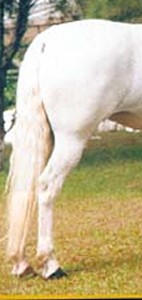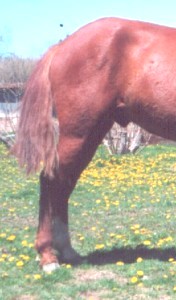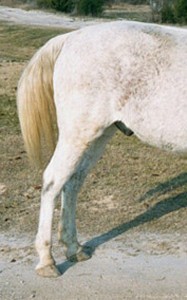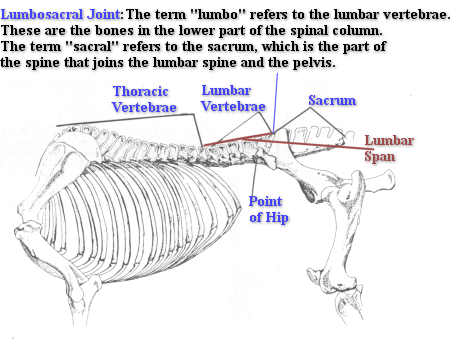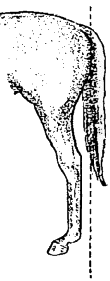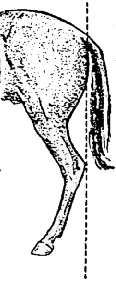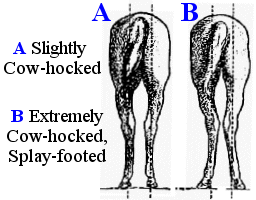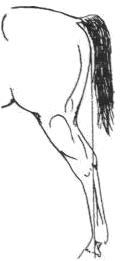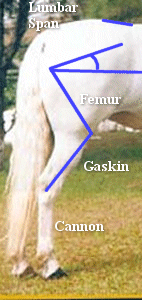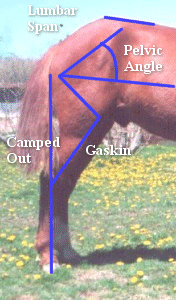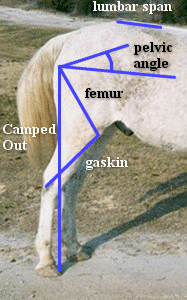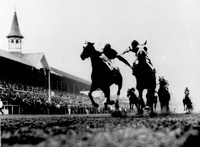| When evaluating a horses’ hindquarters we must first understand the importance of its function to the horses body. The hindquarters are “the power source” for forward and upward movement. This power source is used to distribute the weight off the front quarters when the horse is in motion.
Just as with the front quarters, the hindquarters must be evaluated for the strong and weak points in the structure. This is important to be able understand how to correctly engage the hindquarters for maximum efficiency of gaits without undue stress.
This stress can come from:
- Asking an individual to do more with their hindquarters than their structure will allow.
- Not asking a horse to use itself enough (or correctly) to maintain proper balance.
- Asking a horse to use itself incorrectly for it's specific structure.
This power source of the hindquarters is transferred through the very important lumbosacral joint (where the loins meet the hip). This is the uppermost joint of the horses’ hind limbs.
If this joint is too far behind the point of the hip can cause a horse to go more toward a ventoflexed (hollow) gait. When this joint is closer to aligned over the point of hip this lends the horse more to a dorsiflextion (raised back). The most ventro gait being the pace, less the stepped pace, sobreandondo, rack, corto/ largo. Level, the running walk, slight dorsiflextion towards a fox trot and the trot being the most dorsiflextion.
| Ventroflextion |
Dorsiflextion |
| Pace |
Stepped Pace, Sobreandondo, Rack, Corto/ Largo |
Running Walk |
Foxtrot |
Trot |
The area from the LS joint to the last rib is the Lumbar span. This area being long can also have a horse go toward a ventro gait and short to a dorsiflex gait. To long of functioning back can tend to be vento as well. But keep in mind length of back can be compensated by length of pelvis.
A croup set higher than the wither can also cause a horse to be more ventro in gait. A high croup adds more weight to the front quarters making it harder for a horse to come off the ground in front and increasing concussion to the front hoofs. This can make for an uncomfortable ride.
A well balanced horse from front to back (such as a good TWH) is:
- Up hill from stifle to elbow
- Down hill from hock to knee
- The cannon bone is still short but has a long gaskin and shorter femur.
Remember that too much (or too little) of any specific component in desired hind structure can throw off the balance for a specific gait.
Also in evaluation, take into consideration the hind limbs: are they straight or more angular.
Being too straight can cause:
- A stressed horse to become a stifled horse.
- Being too straight such as a post legged horse can also make for a rougher gait.
|
|
| Then there is sickle-hocked, which can put strain on the back of the hocks. It is not uncommon to see sickle hocks in some of our gaited breeds. The reason being to help a horse to get under it's self. A little bit of sickle hocks may be fine but I see it having (in some cases) gone far beyond the expectable limits for prolonged sound function. |
|
|
Cow hocked has been taken to the extremes in some of the gaited breeds. A horse that is cow hocked puts more stress on the inside of the hock and the stifle. This is due to the stifle being pushed out, away from the side of the horse. A true cow hocked horse will also toe out and not be an efficient stopper and can be a rather sloppy mover behind. |
| Being camped out behind is not uncommon in some gaited horses. A true camped out horse is one that the cannon bone is not perpendicular to the ground, but are angled behind the hock. A horse that camps out behind can have more difficulty coiling the loins to bring the hocks under the body. |
|
So far what I have covered is just a small start in all the factors that can effect hindquarter engagement. In looking for the easier points first, you will start to develop a good eye for the finer ones. Our gaited horses can have quite a variation and combinations of hindquarter structure! This is more evident in some of the American breeds that are made up of several other breeds.
Knowing what the gaits are and how they can be effected by a specific factor in the structure will lead to a better understanding of how to develop the natural gaits of our horses. It is also important to breed for the strong points of structure that each breed needs to support their signature gait.
|
Rear End One |
This horse looks to be rather well balanced in the hindquarters but in relation to gait this horse is to long in the cannons and short in the gaskin to have overstride of the running walk. The length of the cannons making for a longer lever would cause this horse to lift the hocks higher before reaching forward. The femur, gaskin ratio looks to be rather even and the lumbar span being short would make this horse go more to a trotting gait. This horse also looks to be short backed. So with all these combinations makes this horse more to move in dorsiflextion. |
|
Rear End Two |
This horse shows many interesting factors that could make for a less than comfortable ride. First the length of the hindquarters looks short; it does not look like it goes with the back and barrel of the horse. This horse is high in the croup making for a down hill horse to the front. This will make this horse heavy on the front. The lumbar span is long and could make this horse go very ventro being high in the croup as well. The pelvic angle on this horse is very steep making it very hard for this horse to get it's hindquarters up under it's self this also is causing this horse to be camped out behind. # 2 horse also shows being very toed out .The gaskin is longer than the femur. #2 horse would tend to go to a ventroflexed gait that being a very uncomfortable pace if he has the genetics to gait.
|
|
Rear End Three |
# 3 has a bit longer hip and flatter pelvis angle than #2 and lumbar span more over the point of hip. The femur, gaskin ratio is about even. The right leg looks to be camped out but then look at the left hind and it is more under the horse. This makes it very hard to evaluate. The left hind also looks to be toeing out where the right does not. This horse looks to also lack any conditioning. In relation to achieving gait with this structure it seems to tend more to a dorsiflexed gait possibly a fox trot.
|
These three horse are very different in how they are put together. Add the factor that we do not know in looking at a still picture what their genetic tendencies to gait are but we can tell by structure where they will excel or be limited by when we put all the elements together. | 